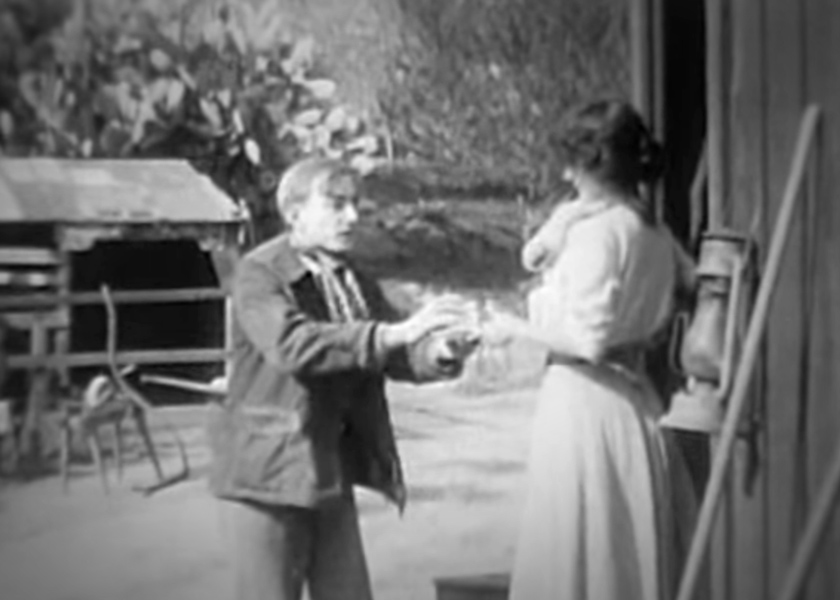Synopsis
Olaf (Carey) sits by the bed of his dying mother. After her death, Olaf, with no reason to remain in their small cabin, bundles his possessions into a sack. He tenderly puts his mother’s small hat into it. He puts a sandwich into his pocket.
As he walks away, Olaf passes an elderly man who begs for aid. Olaf gives him the sandwich. A blacksmith gives Olaf a job helping at the anvil. Olaf is unable to strike in unison with the blacksmith and is fired. Walking along the railroad track, Olaf is accousted by three tramps. He has nothing but his mother’s hat. One of the tramps grabs the hat. Olaf protests. Another tramp gives it back and tells Olaf to go on his way.
From a hill, Olaf looks down on a small farm. Inside the house, the husband (Mailes) shows his wife (McDowell), who is holding their baby, the homesteading papers for the farm. The husband goes to his farm work. Olaf arrives and asks the wife for food. She gives him a sandwich and a drink. He thanks her and leaves. On the hillside overlooking the farm, Olaf rests under a bush. Two men are surveying the farmer’s land and intend to file for it. Olaf hears them and rushes to the farmhouse to tell the farmer. The farmer mounts his horse and gallops to the land office to file his claim. The surveyers drive to the land office. Olaf gets on the back of their car and cuts the tires. He hides as they change tires. As they set off again, Olaf gets back on. They are catching up with the farmer, and one of the men is pointing a gun at him. Olaf jumps them from behind and takes the gun. He tells the farmer to go on and file his papers. Olaf will hold the men. As Olaf turns to watch the farmer, one of them hits him on the head. The surveyers rush to the land office, but the farmer arrives first and files his claim. The farmer rides home to his wife. They rejoice.
Olaf, his head bleeding, gets up and staggers away. He puts a bandage on his head. From the hilltop, he looks down on the farmhouse before walking away.
Discussion
In Olaf—An Atom scenarist William E. Wing and director Anthony O'Sullivan offer a one-reel observation of the interactions of a lone man with his fellow men. These interactions are mostly cool and unsocial. The men he meets are aggressive and threatening (the tramps), heartless (the blacksmith), or thankless (the elderly man and the farmer). Only the woman, who has a baby in her arms, has any empathy, and even she forgets him as the couple celebrate securing the deed to their farm.
Olaf, who has recompensed the woman for her charity, does not ask for reward or thanks. He turns away and continues his solitary wandering.
The title seems to refer to the small piece of humanity represented by Olaf, analogous to an atom, a solitary piece of matter. Olaf interacts with others, but remains separate from them.
The three leading actors, Harry Carey, Claire McDowell, and Charles Hill Mailes, began their film careers with the Biograph Company, the producing studio of Olaf, in 1909. Carey left Biograph about 1914, but McDowell and Mailes remained until the company was dissolved in 1916. All three made dozens of short films, many of them directed by D.W. Griffith, the studio’s principal director and one of the most notable directors in film history. However, Olaf—An Atom was directed by Anthony O’Sullivan, who directed sixty short films, mostly for Biograph, between 1912 and 1915.
The naturalistic style of acting was well established by 1913, especially among actors who had worked with Griffith. The experienced actors in Olaf demonstrate the style by their restrained facial expressions and body movements. Exaggerated expression and movement is associated with the melodramatic style that had greatly declined in screen acting by 1913. Carey’s acting includes some melodramatic moments, noticeably his overexpression of the warning to the farmer.
The Biograph Company is historically important as the studio for which D.W. Griffith directed from 1908. Griffith’s early career is notable for his cinematic innovations and for the number of star players who he brought into the studio. By 1914, feature films (five or more reels in length) became the dominant film form, but Biograph did not modernize its output to meet the new demand. The studio declined quickly after Griffith’s departure in 1913 and ceased operation in 1916.
To meet a demand by movie theaters for films to fill their schedules, Aywon Film Corporation was founded in 1919 to reissue older films. Shorts, including films from Biograph, were often lengthened from one reel to two reels by the addition of intertitles. Olaf—An Atom was retitled The Wanderer when the film was reissued by Aywon in the 1920s. Aywon ceased operation at the end of the silent era.
Today, Olaf—the Atom can be found on YouTube as The Wanderer.
Further Reading

